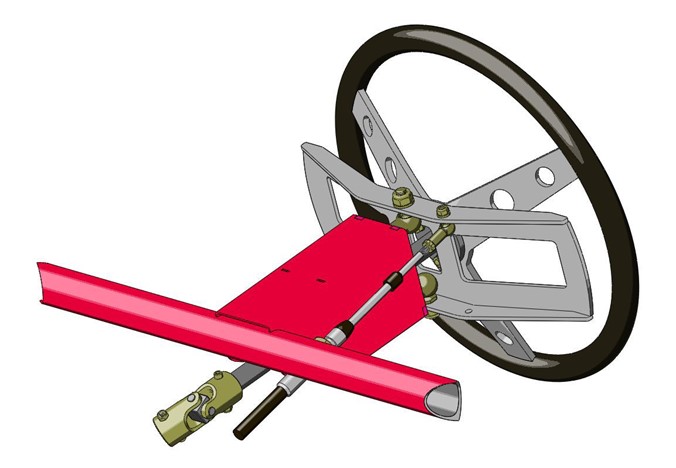If you’ve never raced off-road before, you’re in for a rude shock! The first time someone passes you, and you cop a face and chest full of wet mud, it will make you take your foot off the pedal for an instant!
Your race kit should include a pair of well fitting motocross type goggles(with roll-offs), and probably one of the full-face type motocross helmets, which combined, will keep a certain amount of muck and dust out of your eyes and mouth. But when you’re travelling at speeds of up to 200kmh, and just a few metres behind another buggy, the hail of muck, and stones has to be experienced to be believed! Apart from the loud din such debris can make on the buggy’s bodywork, some of the debris will actually hit your upper body, and can make you flinch!
Some form of primary defence is required, but obviously, the use of a full Perspex/Lexan screen is out of the question, as it would be renderedopaque and useless after the first wheel full of muck landed on it.
Please put your hands together for Stainless Steel Wire Mesh! Stainless mesh is the best choice of material, as it’s tough, and unlike mild steel, it doesn’t rust. Plain, painted steel mesh, and galvanised mesh will lose their coatings eventually due to being “sand blasted”. Stainless mesh is also available in woven and welded varieties, and both will lend themselves to folding and conventional sheet-metal forming techniques.
Using 19mm X 19mm X 2.5mm (¾” X ¾” X 12 gauge) welded or woven mesh will offer in excess of 75% visibility.
R6 Mesh Screen
The simplest way to make up a screen for the R6 is to start with a cardboard template. Copy the dimensions for the template from drawing # 92. If you previously bought R6 Plans prior to 7/3/03, please contact me for a copy of the template drawing.
After folding the cardboard template, and adjusting it to suit the chassis, lay it flat on a sheet of stainless mesh. Clip the template onto the meshwith a couple of clothes pegs, and then cut out the screen and fold it.
Carefully bend some Ø 3mm stainless wire to the outline of the screen, and TIG or gas-weld it to the perimeter of the mesh.
If you prefer, take the template (noting the angle of the folds) to a commercial wire works (the type that make supermarket display shelves), and get them to fabricate the screen.
Radiator Screen
Radiators are crucial to maintaining correct engine temperature and performance. If the radiator isn’t performing optimally, not only can the engine overheat, causing performance to drop, but also, costly damage can occur too. The radiator fins are extremely delicate, and if bent or clogged with debris, will reduce its efficiency. Even the pressure of a direct hit from the garden hose, can be enough to damage the fins.
Stainless mesh to the rescue again! Or to be more accurate, woven stainless cloth, with five 22 gauge (0.71mm) wires per inch, which is approximately 70% open.
Cut the wire cloth to the size of your radiator, but add about 25mm extra to the edges adjacent to the radiator mounting brackets. This is to allow the screen to attach in front of the radiator.
Like most fabrics, wire cloth will fray around its edges if they’re not sealed. Sealing the edges is simple, and offers a sound area for attaching some sticky-backed Velcro tape for mounting.
I use “Plasti Dip” to seal the edges of the screens. It’s a thick liquid plastic, commonly used for dipping tool handles into, for an instant, insulated grip. It’s available from industrial tool supply shops and hardware stores.
Cut a length of steel or aluminium 50mm X 50mm angle, longer than the longest edge you’re going to dip. Take some putty or Plasticine, and block up the ends of the length of angle, thus creating a V shaped trough. Support the trough, and fill with the liquid plastic to a depth of about 25mm.
Dip one of the edges of the screen that will become the mounting faces, into the plastic to the full 25mm depth. Slowly remove, and suspend until dry. Repeat with the other mounting edge. With the remaining two edges, it’s only necessary to dip the screen in to a depth of about two or three horizontal wires. If necessary, repeat the whole process to attain a firm plastic margin.
Self adhesive Velcro can now be stuck to the wide margins of the screen, and also to the radiator mounts on the chassis. The screen can then be quickly removed between races, and gently patted to remove any muck.
Occasionally flush the radiator fins clean by very gently directing a hose into the radiator from the back, to force the debris back out the way it entered.
Stainless steel wire mesh and Plasti Dip suppliers:
Australia – Boral Melwire Pty Ltd/Melwire Pty Ltd, in your capital city.
U.K. – www.wiremesh.co.uk
U.S.A. – www.wovenwire.com
Plasti Dip: www.plastidip.com



